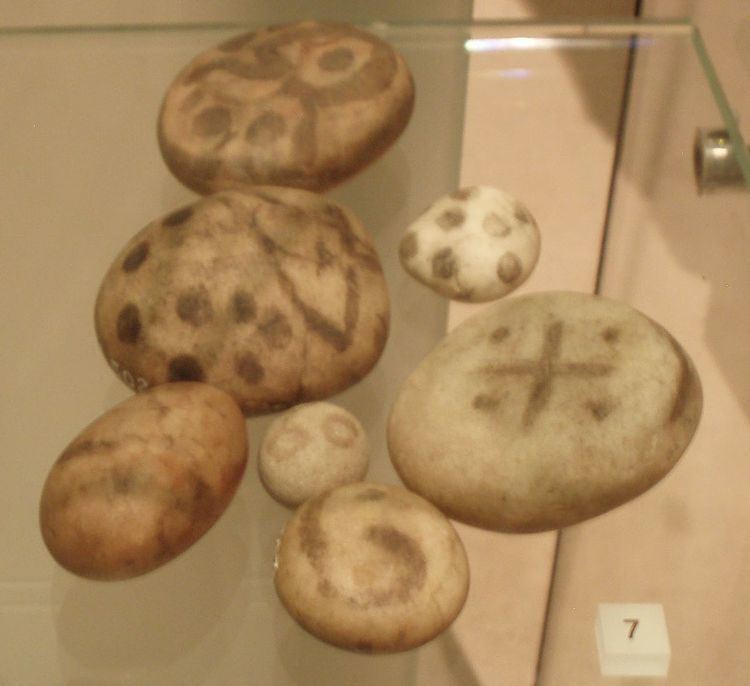 | ||
Painted pebbles are a class of Pictish artifact found in northern Scotland dating from the first millennium AD. They are comparable to those that characterize the Azilian period in the Art of the Upper Paleolithic on the continent.
Contents
Appearance
They are small rounded beach pebbles made of quartzite, which have been painted with simple designs in a dye which is now dark brown in colour. The size varies from 18 mm by 22 mm to 65 mm by 51mm. It has not proven possible to analyse the dye itself from the stains that remain.
The motifs are carefully executed and the most common are dots and wavy lines. Other motifs are small circles, pentacles, crescents and triangles, showing strong relationships with the Pictish symbol stone motifs.
Distribution
Over the last 90 years, 19 painted pebbles have been found in sites in the Northern Isles and in Caithness. Most have come from broch sites which have been shown to have had an extensive post-broch occupation. An ogham-inscribed spindle-whorl was associated with one find at Buckquoy in Orkney (see Buckquoy spindle whorl). Several have been associate with wheelhouses or their outbuildings. An example was found at a Pictish site at Buckquoy in Orkney as reported in 1976. It had the "small ring" type decoration.
Cultural significance
Scottish Painted pebbles have been dated to the period 200 AD to the eighth century AD, the Pictish period. They may have been sling-stones that were thought to be of magical nature by the picts, however local traditions suggest that they were 'charm-stones', often known as 'Cold-stones'. Such stones were used within living memory (1971) to cure sickness in animals and humans.
Robert Burns's Highland Mary is said to have been treated using charm-stones when she lay dying at Greenock in 1786. Some superstitious friends believed that her illness was as a result of someone casting the evil eye upon her and her father was urged to go to a place where two streams meet, select seven smooth stones, boil them in milk, and treat her with the potion.
In the Life of St. Columba it is recorded that he visited King Bridei in Pictland in around the year 565 AD and taking a white stone pebble from the River Ness he blessed it and any water it came into contact with would cure sick people. It floated in water and cured the king from a terminal illness. It remained as one of the great treasures of the king and cured many others.
The belief in charm-stones is well documented in medieval Iceland (Proc Soc Antiq Scot).
Examples of 'charm-stones' or 'cold-stones' are held at National Museum of Rural Life, Kittochside, near East Kilbride.
At Kilwhinlick near Kilmorie on the Isle of Bute in Scotland were kept the 'Blessed Stones' which were boiled up in a 'certain drink' and used to restore the flow of milk that witches that caused to cease.
